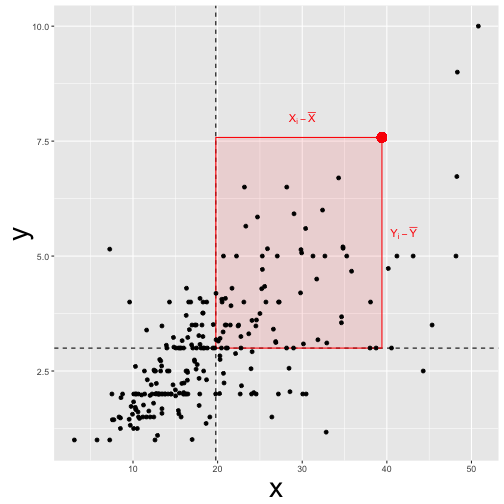Correlation is one of the most widely used and a well-known measure of the assocation (linear association, that is) of two variables.
Perhaps less well-known is that the correlation is in principle analoguous to the covariation.
To see this, consider the a formula of the covariance of two empirical datasets, $X$ and $Y$:
$$COV(X,Y) = \frac{1}{n} \cdot \big( \sum (X_i -\bar{X}) \cdot (Y_i - \bar{Y}) \big) $$
In other words, the covariance of $X$ and $Y$ $COV(X,Y)$ is the average of difference of some value to its mean.
This idea is conveyed by this picture:

The covariance is identical to the correlation (?)
What does it mean to say the (coefficient of) correlation is “identical” to the covariation?
If we “feed” z-scaled values to the covariation, we will get back the correlation.
In other words, the correlation equals the covariation if the data are z-scaled.
So, let’s see. We replace $X$ by $z_X$ and $Y$ by $z_Y$ and see what happens.
$$Cov(z_X, z_Y) = \frac{1}{n} \cdot \sum $$
\sum (z_{X_i} - z_{\bar{X}}) (z_{Y_i} - z_{\bar{Y}})
However, $z_{\bar{X}} = 0$, and by analogy, $z_{\bar{y}} = 0$. So the eqaution simplifies to
$$Cov(z_X, z_Y) = \frac{1}{n} \cdot \sum (z_{X_i} \cdot z_{Y_i}) $$
Now, $z_x$ can be expressed as
$$z_x = \frac{X_i - \bar{X}}{sd_X}$$
The same rule applies for $z_y$ by analogy.
Now, let’s insert the previous equation in the equation of $Cov(z_X, z_Y)$:
$$Cov(z_X, z_Y) = \frac{1}{n} \cdot \big( \sum \frac{X_i - \bar{X}}{sd_X} \cdot \frac{Y_i - \bar{Y}}{sd_Y} \big)$$
$sd_X$ and $sd_Y$ can be pulled out of the sum, right at the front of the equation, leaving us with
$$Cov(z_X, z_Y) = \frac{1}{sd_X \cdot sd_Y} \cdot \big( \sum (X_i - \bar{X}) \cdot (Y_i - \bar{Y}) \big)$$
And that’s the definition of the correlation of $X$ and $Y$, more frequently put this way:
$$Cov(z_X, z_Y) = \frac {\sum (X_i - \bar{X}) \cdot (Y_i - \bar{Y})}{sd_X \cdot sd_Y}$$
Hence,
$$Cov(z_X, z_Y) = cor(X,Y)$$
Example time
It is helpful to consider an example.
This is a scatterplot of two variables, ie., “raw data” as is “fed in” for the calculation of the (empirical) covariation:
library(tidyverse)
mtcars %>%
ggplot +
aes(x = hp, y = mpg) +
geom_point()

And now, let’s z-scale the two variables and draw the same diagram again:
mtcars %>%
select(hp, mpg) %>%
mutate_all(funs(scale)) %>%
ggplot +
aes(x = hp, y = mpg) +
geom_point()

Now, what’s the difference? Nada, no difference. That’s reassuring, because we just derived that the assocation of the variables is the same - no matter if use the raw data or z-scaled data as input. The diagrams confirms this in an more intuitive way.
Summary
The correlation is a “special case” of the covariance; it is the case when we feed z-scaled data to the covariance.
Happy data analyzing!